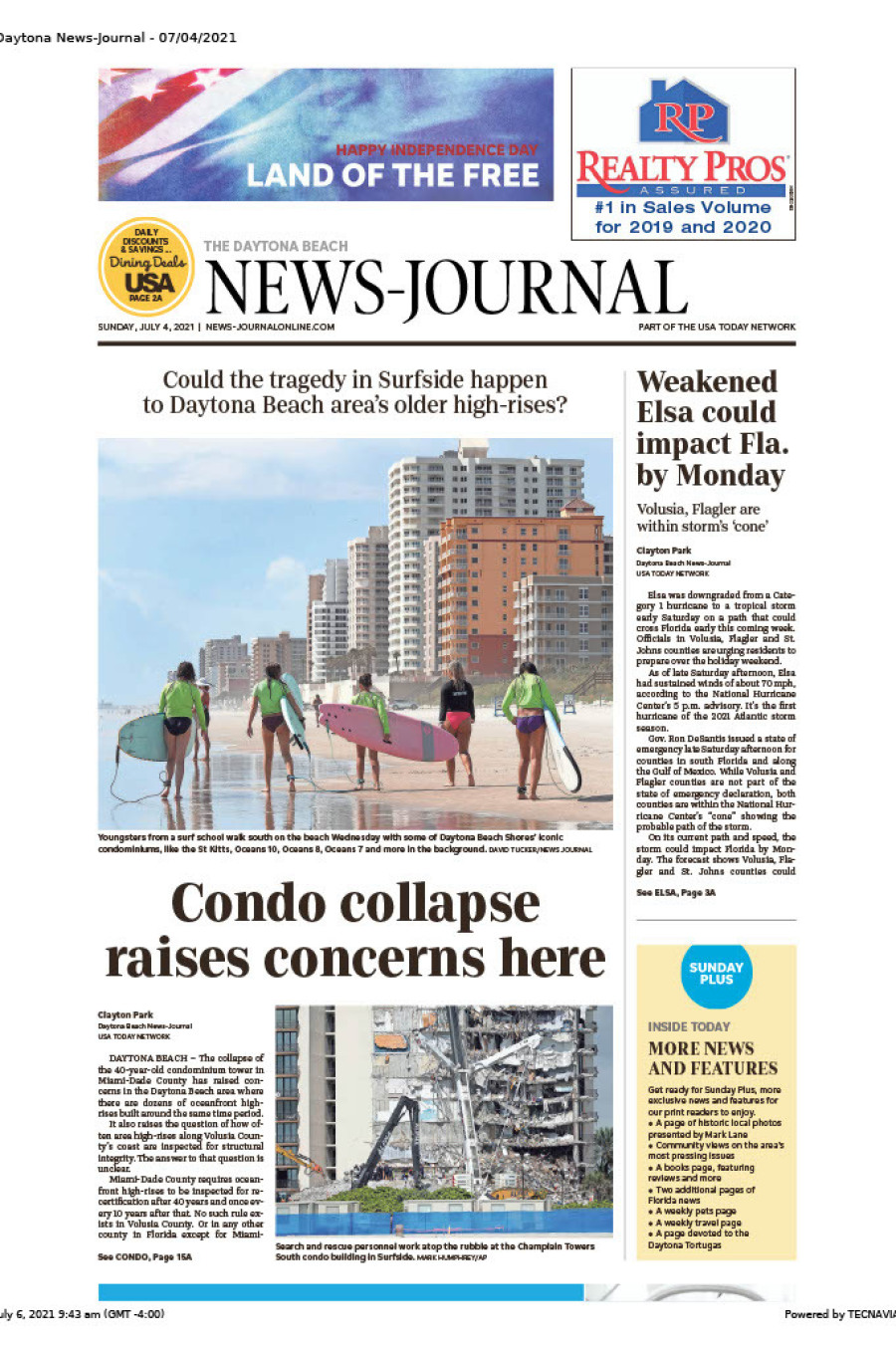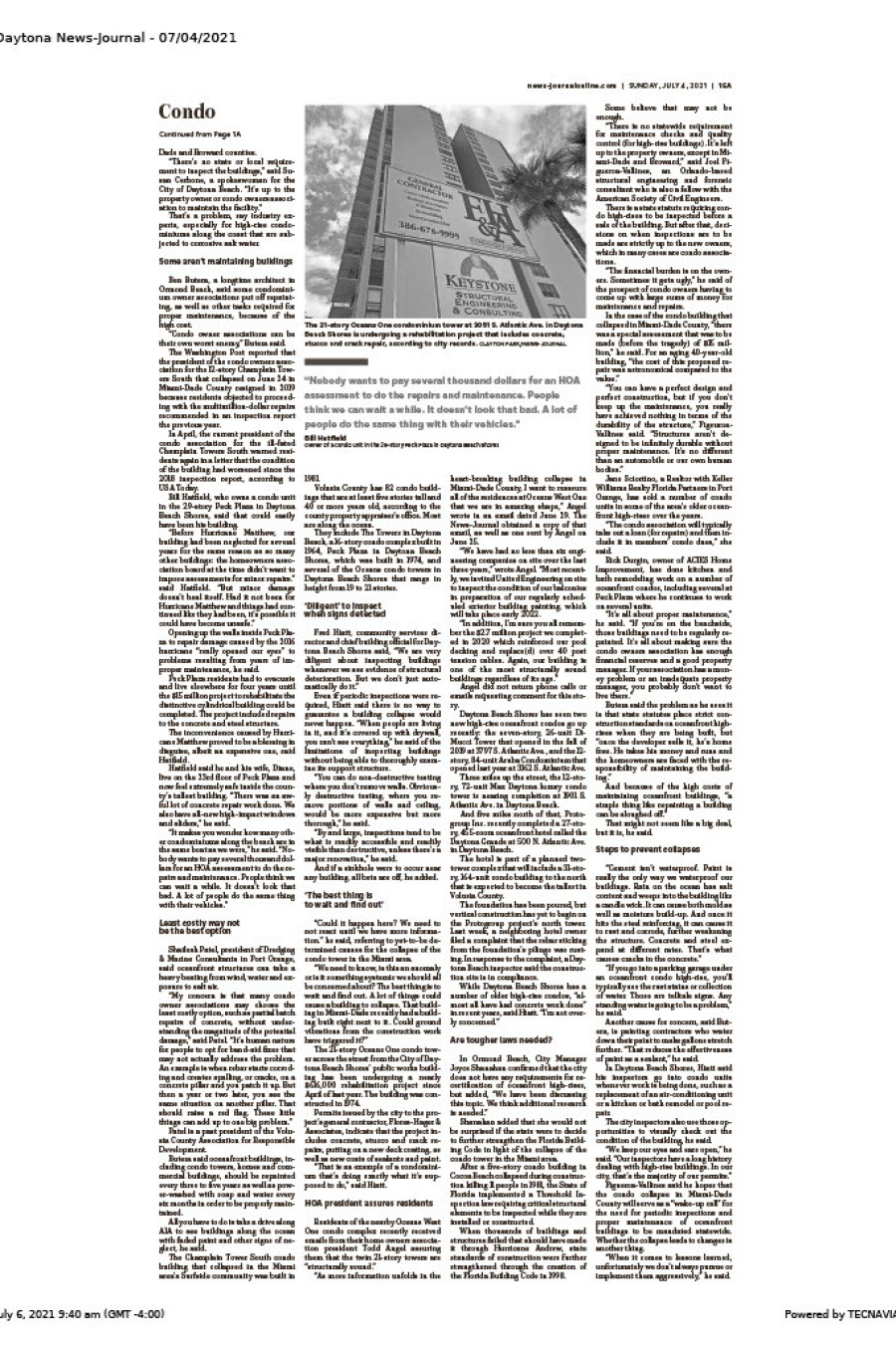Hatfield said he and his wife, Diane, live on the 23rd floor of Peck Plaza and now feel extremely safe inside the county’s tallest building. “There was an awful lot of concrete
repair work done. We also have all-new high-impact windows and sliders,” he said.
“It makes you wonder how many other condominiums along the beach are in the same boat as we were,” he said. “Nobody wants to pay several thousand dollars for an HOA assessment
to do the repairs and maintenance. People think we can wait a while. It doesn’t look that bad. A lot of people do the same thing with their vehicles.”
Least costly may not be the best option
Shailesh Patel, president of Dredging & Marine Consultants in Port Orange, said oceanfront structures can take a heavy beating from wind, water and exposure to salt
air. “My concern is that many condo owner associations may choose the least costly option, such as partial batch repairs of concrete, without understanding the
magnitude of the potential damage,” said Patel. “It’s human nature for people to opt for band-aid fixes that may not actually address the problem. An example is when rebar starts
corroding and creates spalling, or cracks, on a concrete pillar and you patch it up. But then a year or two later, you see the same situation on another pillar. That should
raise a red flag. These little things can add up to one big problem.” Patel is a past president of the Volusia County Association for Responsible Development.
Butera said oceanfront buildings, including condo towers, homes and commercial buildings, should be repainted every three to five years as well as power-washed with soap and water
every six months in order to be properly maintained. All you have to do is take a drive along A1A to see buildings along the ocean with faded paint and other signs of
neglect, he said.
The Champlain Tower South condo building that collapsed in the Miami area’s Surfside community was built in 1981.
Volusia County has 82 condo buildings that are at least five stories tall and 40 or more years old, according to the county property appraiser’s office. Most are along the
ocean. They include The Towers in Daytona Beach, a 16-story condo complex built in 1964, Peck Plaza in Daytona Beach Shores, which was built in 1974, and several of the
Oceans condo towers in Daytona Beach Shores that range in height from 19 to 21 stories.
‘Diligent’ to inspect when signs detected
Fred Hiatt, community services director and chief building official for Daytona Beach Shores said, “We are very diligent about inspecting buildings whenever we see evidence of
structural deterioration. But we don’t just automatically do it.” Even if periodic inspections were required, Hiatt said there is no way to guarantee a building
collapse would never happen. “When people are living in it, and it’s covered up with drywall, you can’t see everything,” he said of the limitations of inspecting buildings
without being able to thoroughly examine its support structure.
“You can do non-destructive testing where you don’t remove walls. Obviously destructive testing, where you remove portions of walls and ceiling, would be more expensive but
more thorough,” he said. “By and large, inspections tend to be what is readily accessible and readily visible than destructive, unless there’s a major renovation,” he
said. And if a sinkhole were to occur near
any building, all bets are off, he added.
“Could it happen here? We need to not react until we have more information.” he said, referring to yet-to-be determined causes for the collapse of the condo tower in the
Miami area. “We need to know, is this an anomaly or is it something systemic we should all be concerned about? The best thing is to wait and find out. A lot of things
could cause a building to collapse. That building in Miami-Dade recently had a building built right next to it. Could ground vibrations from the construction work have
triggered it?”
The 21-story Oceans One condo tower across the street from the City of Daytona Beach Shores’ public works building has been undergoing a nearly $616,000 rehabilitation project
since April of last year. The building was constructed in 1974. Permits issued by the city to the project’s general contractor, Flores-Hager
& Associates, indicate that the project includes concrete, stucco and crack repairs, putting on a new deck coating, as well as new coats of sealants and paint.
“That is an example of a condominium that’s doing exactly what it’s supposed to do,” said Hiatt.
HOA president assures residents of the nearby Oceans West One condo complex recently received emails from their home owners association president Todd Angel assuring them that
the twin 21-story towers are “structurally sound.”
“As more information unfolds in the heart-breaking building collapse in Miami-Dade County, I want to reassure all of the residences at Oceans West One that we are in amazing
shape,” Angel wrote in an email dated June 29. The News-Journal obtained a copy of that email, as well as one sent by Angel on June 25. “We have had no less than six
engineering companies on site over the last three years,” wrote Angel. “Most recently, we invited United Engineering on site to inspect the condition of our balconies in
preparation of our regularly scheduled exterior building painting, which will take place early 2022. “In addition, I’m sure you all remember the $2.7 million project we
completed in 2020 which reinforced our pool decking and replace(d) over 40 post tension cables. Again, our building is one of the most structurally sound buildings regardless
of its age.” Angel did not return phone calls or emails requesting comment for this story.
Daytona Beach Shores has seen two new high-rise oceanfront condos go up recently: the seven-story, 26-unit Di-Mucci Tower that opened in the fall of 2019 at 3797 S. Atlantic Ave., and
the 12-story, 84-unit Aruba Condominium that opened last year at 3162 S. Atlantic Ave. Three miles up the street, the 12-story, 72-unit Max Daytona luxury condo tower is
nearing completion at 1901 S. Atlantic Ave. in Daytona Beach. And five miles north of that, Protogroup Inc. recently completed a 27-story, 455-room oceanfront hotel called
the Daytona Grande at 500 N. Atlantic Ave. in Daytona Beach. The hotel is part of a planned two-tower complex that will include a 31-story, 164-unit condo building to
the north that is expected to become the tallest in Volusia County.
The foundation has been poured, but vertical construction has yet to begin on the Protogroup project’s north tower. Last week, a neighboring hotel owner filed a complaint
that the rebar sticking from the foundation’s pilings was rusting. In response to the complaint, a Daytona Beach inspector said the construction site is in
compliance. While Daytona Beach Shores has a number of older high-rise condos, “almost all have had concrete work done” in recent years, said Hiatt. “I’m not
overly concerned.”
Are tougher laws needed?
In Ormond Beach, City Manager Joyce Shanahan confirmed that the city does not have any requirements for recertification of oceanfront high-rises, but added, “We have been
discussing this topic. We think additional research is needed.” Shanahan added that she would not be surprised if the state were to decide to further strengthen the
Florida Building Code in light of the collapse of the condo tower in the Miami area.
After a five-story condo building in Cocoa Beach collapsed during construction killing 11 people in 1981, the State of Florida implemented a Threshold Inspection law requiring
critical structural elements to be inspected while they are installed or constructed. When thousands of buildings and structures failed that should have made it through
Hurricane Andrew, state standards of construction were further strengthened through the creation of the Florida Building Code in 1998.
Some believe that may not be enough. “There is no statewide requirement for maintenance checks and quality control (for high-rise buildings). It’s left up to the
property owners, except in Miami-Dade and Broward,” said Joel Figueroa-Vallines, an Orlando-based structural engineering and forensic consultant who is also a fellow with the American
Society of Civil Engineers.
There is a state statute requiring condo high-rises to be inspected before a sale of the building. But after that, decisions on when inspections are to be made are strictly up
to the new owners, which in many cases are condo associations. “The financial burden is on the owners. Sometimes it gets ugly,” he said of the prospect of condo owners
having to come up with large sums of money for maintenance and repairs. In the case of the condo building that collapsed in Miami-Dade County, “there was a special
assessment that was to be made (before the tragedy) of $15 million,”he said. For an aging 40-year-old building, “the cost of this proposed repair was astronomical compared to
the value.”
“You can have a perfect design and perfect construction, but if you don’t keep up the maintenance, you really have achieved nothing in terms of the durability of the structure,”
Figeuroa-Vallines said. “Structures aren’t designed to be infinitely durable without proper maintenance. It’s no different than an automobile or our own human bodies.”
Jane Sciortino, a Realtor with Keller Williams Realty Florida Partners in Port Orange, has sold a number of condo units in some of the area’s older oceanfront high-rises over the
years. “The condo association will typically take out a loan (for repairs) and then include it in members’ condo dues,” she said.
Rick Durgin, owner of ACIES Home Improvement, has done kitchen and bath remodeling work on a number of oceanfront condos, including several at Peck Plaza where he continues to
work on several units. “It’s all about proper maintenance,” he said. “If you’re on the beachside, those buildings need to be regularly repainted. It’s all about
making sure the condo owners association has enough financial reserves and a good property manager. If your association has a money problem or an inadequate property manager,
you probably don’t want to live there.”
Butera said the problem as he sees it is that state statutes place strict construction standards on oceanfront highrises when they are being built, but “once the developer sells it,
he’s home free. He takes his money and runs and the homeowners are faced with the responsibility of maintaining the building.” And because of the high costs
of maintaining oceanfront buildings, “a simple thing like repainting a building can be sloughed off.” That might not seem like a big deal, but it is, he said.
Steps to prevent collapses
“Cement isn’t waterproof. Paint is really the only way we waterproof our buildings. Rain on the ocean has salt content and weeps into the building like a candle wick. It can
cause both mold as well as moisture build-up. And once it hits the steel reinforcing, it can cause it to rust and corrode, further weakening the structure. Concrete and steel
expand at different rates. That’s what causes cracks in the concrete.”
“If you go into a parking garage under an oceanfront condo high-rise, you’ll typically see the rust stains or collection of water. Those are telltale signs. Any standing water is
going to be a problem,” he said. Another cause for concern, said Butera, is painting contractors who water down their paint to make gallons stretch further. “That
reduces the effectiveness of paint as a sealant,” he said.
In Daytona Beach Shores, Hiatt said his inspectors go into condo units whenever work is being done, such as a replacement of an air-conditioning unit or a kitchen or bath remodel
or pool repair. The city inspectors also use those opportunities to visually check out the condition of the building, he said. “We keep our eyes and ears open,”
he said. “Our inspectors have a long history dealing with high-rise buildings. In our city, that’s the majority of our permits.”
Figueroa-Vallines said he hopes that the condo collapse in Miami-Dade County will serve as a “wake-up call” for the need for periodic inspections and proper maintenance of
oceanfront buildings to be mandated statewide. Whether the collapse leads to changes is another thing. “When it comes to lessons learned, unfortunately we don’t
always pursue or implement them aggressively,” he said.



